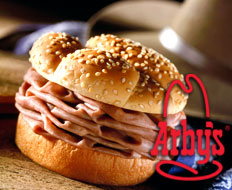Just two years after getting hitched, Wendy’s and Arby’s may be breaking up. But few analysts are surprised.
Wendy’s/Arby’s Group Inc., the Atlanta-based company that owns the two quick-service restaurant brands, said last week that it is seeking “strategic alternatives” for Arby’s, including a possible sale of the struggling roast beef sandwich chain.
“The reality is that the Wendy’s brand, given its relative size and scope, is the key driver of shareholder return,” chairman Nelson Peltz said bluntly in a statement.
Peltz, an investor who brought the two chains together, said Wendy’s/Arby’s would be best served by focusing its management and financial assets on growing Wendy’s, the No. 3 burger chain with some 6,500 restaurants in more than 20 countries.
Financial analysts who track the company say Arby’s could draw anywhere from $335 million to more than $600 million. The most likely buyer, they say, would be a private-equity company looking to turn around the chain in order to sell it after a few years.
Wendy’s/Arby’s did not disclose whether it had been contacted by a potential buyer, and “there’s no timetable for the review” of alternatives, says spokesman Bob Bertini.
The announcement about Arby’s came just two days after competitor Yum Brands Inc. announced it would sell two of its brands, Long John Silver’s and A&W All-American restaurants, to focus on its other concepts, KFC, Pizza Hut, and Taco Bell.
Restaurant industry acquisition activity picked up last year, led by 3G Capital’s $3.9 billion purchase of Burger King and Apollo Management LP’s purchase of CKE Restaurants for $1 billion.
Arby's is the nation's second-biggest quick-service sandwich chain with nearly 3,700 units and $1 billion in sales last year, less than half the $2.4 billion recorded by Wendy's.
The parent company reported yesterday that it lost $4.3 million in 2010 after earning $3.5 million the previous year. Sales at Arby’s stores open more than a year declined 5.8 percent from 2009, while same-store sales at Wendy’s were off a slight 0.6 percent. And while margins at company-operated Arby’s restaurants slid to 11.6 percent last year from 13.4 percent a year earlier, Wendy’s restaurant margins were virtually flat at 14.8 percent.
“Wendy’s is by far the more successful of the two chains,” says Joscelyn MacKay, a financial analyst and credit specialist at Morningstar Inc., a Chicago-based investment research firm. “Arby’s has been destroying the company’s shareholder value.”
Arby’s, which Peltz acquired in 1993 as part of a larger deal, suffered double-digit-percentage same-store sales declines the first two years after it merged with Wendy’s in a $2.3 billion all-stock deal that closed in fall 2008.
Peltz owns about one-fourth of Wendy’s/Arby’s shares through his investment firm Trian Fund Management.
The problems at Arby’s, however, are chronic and go back much further than the Wendy’s deal, says Vicki Bryan, a Chicago-based bond analyst with Gimme Credit LLC. She points to an unfocused and expensive menu, poor marketing, and inconsistent store performance.
“There has been no material improvement, in our view, in Arby’s operations and management for more than a decade, during which time the value of the brand eroded considerably,” Bryan said in an e-mail to QSR.
Analysts say the economic downturn hit Arby’s harder than most quick serves because of the chain’s relatively pricy sandwiches and lack of a $1 menu. Diners turned to less expensive alternatives during the recession, forcing Arby’s to build a value menu.
Management “couldn’t just take a few of their products and put them on the value menu, because those items weren’t there,” MacKay says. “They had to create a whole new menu, and that took time—too much time.”
Weak sales during the past three years “have led to significant margin and profit deterioration” at the sandwich chain, said Chris O’Cull, a financial analyst at Atlanta-based investment firm SunTrust Robinson Humphrey, in a report to clients. O’Cull estimated that earnings before costs dropped by two-thirds during that period.
Arby’s not only responded by initiating its $1 menu last year but also by lowering other prices and making some management changes. Bryan says the steps may have been taken to spruce up the chain for a sale.
Still, the moves appear to be showing some traction. Arby’s same-store sales jumped 3.1 percent during the final three months of the year over 2009’s final quarter, the first year-over-year increase in years, said Deustche Bank analyst Jason West.
“One could argue that [Wendy’s/Arby’s] is selling the Arby’s brand at a cyclical trough,” which could help improve its sales value, West said in a report to clients.
O’Cull said in his report that Arby’s is in the early stages of a brand recovery. He said the steps taken so far “can be successful in conjunction with a more robust national media strategy.”
That, however, will be costly and time consuming, analysts say, giving Wendy’s/Arby’s one more reason to sell the chain.







